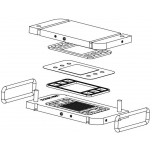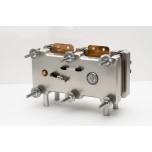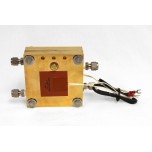PEM Fuel Cell Hardware
Fuel Cell Hardware is an electrochemical device that converts chemical fuel, such as hydrogen, natural gas, methanol, etc. into energy and water. This item includes all the key components to make such reactions occur. It also performs compression of the membrane electrode assembly (MEA) while providing uniform gas distribution and uniform temperature to the cell.
A gold-plated plate serves as current collector plate for the fuel cell. The gold plating provides corrosion protection and good electrical contact with the graphite separator plate. A high purity graphite plate with high electrical conductivity (900 Scm-1) and high thermal conductivity (117 Wm-1K-1) is designed with serpentine gas flow channels and manifold. A gasket is included to provide a secured seal for the MEA. High power silicon rubber heaters are installed at both ends of the fuel cell to maintain a constant cell temperature.
✔ Nylon fittings for gas tight connection to 1/4" tuibing (for active area sizes of 1, 5, and 25 cm2)
✔ Stainless Steel fittings for gas tight connection to 1/4” tubing (for active area sizes of 50 and 100 cm2)
Schematic of the Fuel Cell Hardware's Components:

- Column / Pin Type
- Serpentine
- Straight Channel



A reference electrode provides more accurate measurement of voltage without the effect of current. The reference electrode is used to measure and monitor the electrochemical polarization behavior of individual anode and cathode electrode independently. A metallic Pt wire is installed as a reference at the fuel cell hardware.
The Pt wire reference electrode is generally located in an open compartment independent of the flow field. However, Hydrogen Reference Electrode's Pt wire is located in an open compartment which is connected to the flow field of the fuel cell.
 1. Through-Bolt Assembly Design
1. Through-Bolt Assembly DesignWrite a review
Your Name:
Your Review: Note: HTML is not translated!
Rating: Bad Good
Enter the code in the box below:







































